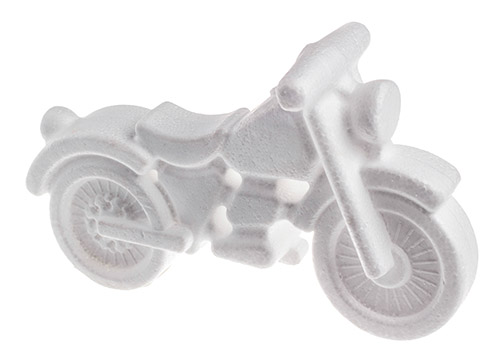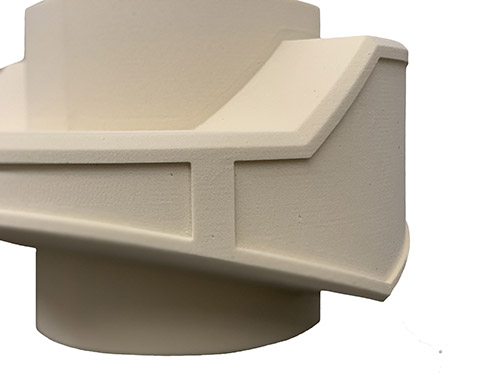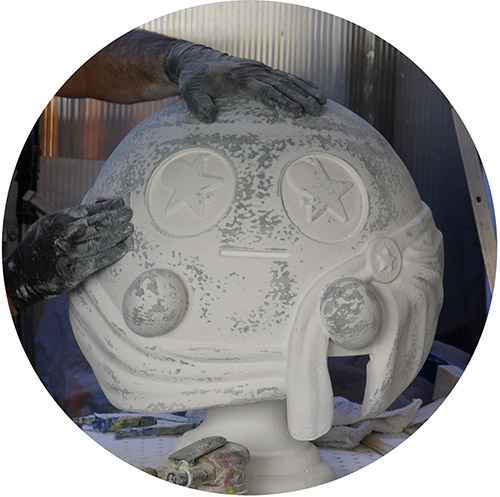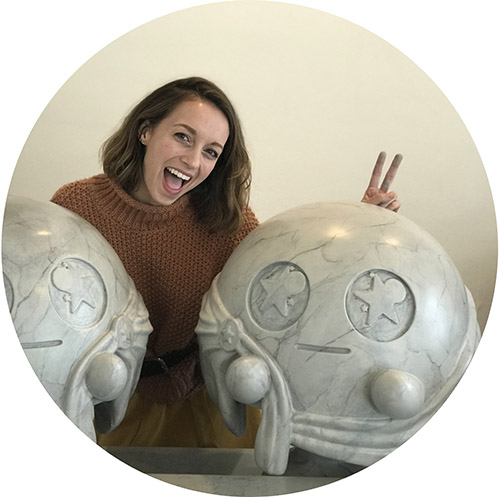Common Applications of Foam Milling
Examples Gallery

Styrofoam EPS Parts
Create styrofoam models in any shape and size. This EPS foam material is lightweight and a good option for models without fine or intricate details.
Get A Quote
Overview
Applications
How to Order
Foam Milling is the process of producing a physical part made of foam material, using a computer-precision 5-Axis CNC mill to carve the part from a block of foam. This process requires a 3D Model CAD file in any of the following file formats: STL, OBJ, STEP/STP, or IGES/IGS.
Foam Sculpting is the process of hand-sculpting foam to achieve a finished physical result that closely matches image references provided by the customer. Hand-sculpting foam is less precise than CNC milling foam, but is perfectly suitable for most types of display pieces, landscapes, or any objects which don't require engineering precision.
Foam CNC machining is widely used for creating precise, detailed parts and prototypes across industries such as automotive, aerospace, and architecture. Foam offers a cost-effective manufacturing solution, allowing for the rapid production of complex shapes and components that can replace traditional tooling methods. The processes involved in foam CNC machining include design, cutting, shaping, and finishing, ensuring efficient and accurate results for molds, patterns, and custom parts.
Most single-part orders are completed within 2-4 days after production begins. Large, oversized parts or orders with high quantities of parts may take longer. All price quotes are given with an estimated lead-time included.
Two options: EPS Styrofoam and High-Density Urethane Foam (HDU).
EPS Stryofoam is an economical option for general-purpose foam models with low complexity, while HDU Foam is significantly stronger and ideal for parts which require high definition and sharply-carved surface detail.
If you have a CAD file, then your parts can be produced using a computer-controlled 5-Axis CNC mill, which carves your part with high-precision based on the three-dimensional data in your CAD file. CAD files should be in one of the following file formats: STL, OBJ, STEP/STP, or IGES/IGS.
If you don't have a CAD file, then an artist can sculpt your foam parts based on your provided image references. The detail will be accurate to the eye, based on the sculptor's interpretation of the provided image references.
If you don't have a CAD file but do require the machine-precision of a 5-Axis CNC mill, we offer 3D Design services to create the CAD files required for this process, based on drawings/dimensions/images that you provide.
Foam milling is a good option for producing parts which otherwise exceed the standard capabilities of 3D Printing. If your model is less than ~[12" x 12" x 12"], then this is probably not a good application for foam milling, as 3D Printing is likely more cost-effective and will produce a stronger and more accurate part in plastic material.
There is no true maximum allowable size for 5-Axis CNC milling or hand-sculpting, since large foam parts can be built in sections and doweled + assembled together.
We can add a polyurea epoxy spray coating to your foam parts, to give them a hard shell which can be sanded and finished. This epoxy hard coating is ~1/16" thick, and has a slightly bumpy "orange peel" texture which can be sanded down smooth to prepare the surface for painting.
CNC foam cutting is a highly versatile and precise manufacturing process that leverages computer numerical control (CNC) technology to automate and streamline the cutting of foam materials. This process is widely adopted across industries such as packaging, automotive, aerospace, and construction, thanks to its ability to produce complex shapes and intricate designs with exceptional accuracy and repeatability. CNC machines are capable of handling a variety of foam materials, including polyurethane, polystyrene, and polyethylene, making them suitable for a broad range of applications.
To achieve the best results, manufacturers employ several cutting techniques tailored to the specific requirements of each project. Rough cutting is used for rapid material removal, allowing for quick shaping of the foam before more detailed work begins. Finishing passes follow, refining the surface and adding high-detail features to the part. For projects that demand complex geometries, multi-axis strategies are utilized, enabling the CNC foam cutting process to create intricate contours and undercuts that would be difficult or impossible with traditional methods.
Optimizing the process involves careful selection of cutting tools, spindle speeds, and cutting paths based on the density and properties of the foam material. For example, softer foam materials may require slower spindle speeds and more aggressive cutting tools to prevent tearing, while denser foams benefit from higher speeds and more precise tooling. By understanding the unique characteristics of each foam type and adjusting the process accordingly, manufacturers can achieve high-quality cuts, minimize material waste, and deliver superior results for a wide range of industries.
The ability to create intricate shapes and undercuts in CNC foam cutting is largely dependent on advanced software and strategic toolpath planning. Two of the most common approaches in CNC machining are 3-axis and 5-axis toolpaths. 3-axis toolpaths are ideal for simpler shapes and are often used for initial rough cutting and material removal. In contrast, 5-axis toolpaths provide greater flexibility, allowing the cutting tool to approach the foam from multiple angles. This capability is essential for producing complex geometries, sharp angles, and detailed undercuts that are often required in custom foam shapes.
For oversized foam parts that exceed the working envelope of a single CNC machine, sectioning and assembly techniques come into play. Large models are divided into manageable sections, each precisely cut and then assembled to form the final product. This approach enables the production of large, intricate foam shapes without sacrificing precision or quality.
Computer-controlled machines play a crucial role in ensuring precise measurements and high accuracy throughout the process. By leveraging advanced toolpaths and strategies, manufacturers can push the boundaries of CNC foam cutting, delivering complex, high-quality products that meet the exacting standards of industries ranging from automotive to architectural design.
Achieving the highest quality in CNC foam cutting requires careful optimization for both the material being used and the level of detail required. Each foam material—whether it’s a soft, low-density foam or a denser, more robust option—has unique properties that influence the cutting process. Softer foams may need more aggressive cutting tools and slower spindle speeds to avoid material distortion, while harder foams benefit from precise tools and higher speeds to capture fine details and sharp edges.
The choice of cutting tool is also critical. End mills and other specialized tools are selected based on the desired finish and the complexity of the design. For projects that demand extremely tight tolerances or intricate details, laser cutting can be integrated into the process, offering even greater precision and the ability to cut complex shapes with minimal material waste.
By tailoring cutting parameters, tooling, and techniques to the specific foam material and project requirements, manufacturers can consistently achieve high-precision cuts and produce complex foam shapes that meet the needs of industries such as automotive, aerospace, and construction. The benefits of CNC foam cutting—including its speed, efficiency, and ability to deliver intricate designs—make it a preferred choice for producing custom foam products with outstanding quality and repeatability.
Examples Gallery

Create styrofoam models in any shape and size. This EPS foam material is lightweight and a good option for models without fine or intricate details.

Polyurethane foam is a denser, more robust material option for models which require finer or more intricate detail. Optiions inclue 4-lb and 6-lb polyurethane foam.

Coat your CNC foam models with a hard epoxy shell surface, so they can be smoothed and painted.

Get fully-finished display pieces, painted to perfection with any color or style.
Get connected to a project manager, and take the next step with your prototyping or fabrication needs.
Get a Quote
To get a price quote for your foam parts, submit a quote request and provide your CAD files in one of the following file formats: STL, OBJ, STEP/STP, or IGES/IGS. A project engineer will review and respond, typically within 15-30 minutes.
If you don't have CAD files, we can hand-sculpt your part based on your reference images. If you need precise foam parts made on a 5-axis CNC mill but don't have CAD files, we provide 3D Design services to produce these 3D Model CAD files for you.
Your foam parts can be made in EPS Styrofoam, or High-Density Urethane (HDU) Foam with 4lb or 6lb density.
EPS Stryofoam is an economical option for general-purpose foam models with low complexity, while HDU Foam is significantly stronger and ideal for parts which require high definition and sharply-carved surface detail.
Your foam parts are created with 5-axis CNC Milling (precise machined detail), or hand-sculpting (professional artist interpretation).
If you need a hard surface over your foam parts for painting + finishing, we can add a polyurea epoxy hard coat to your foam parts.
If you need a large part that must be built in multiple sections, we can dowel and assemble prior to delivery, or we can provide your order in separate pieces.